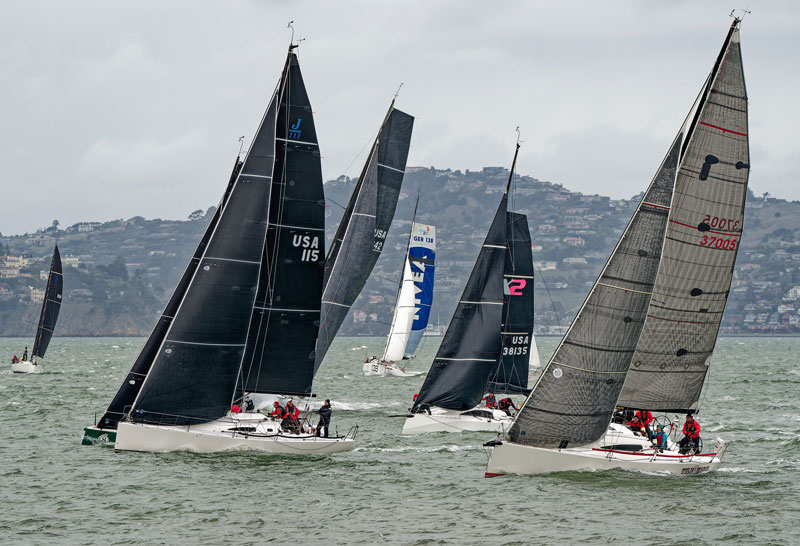
Capsize at Golden Gate Midwinters
Race 3 in Golden Gate Yacht Club’s five-race Seaweed Soup Series was held in gear-busting conditions on January 6. The cold front that blew through brought little actual rainfall but plenty of big, blustery breeze, with short ebb chop. You might compare it to summer sailing in the Slot. The difference was the intensity and shifty nature of the gusts, and the wind direction, with lots of south in it.

GGYC runs one midwinter race on the first Saturday of each month, November-March. In last Saturday’s race, the first leg took the fleet from the start off GGYC’s clubhouse on the San Francisco Marina to a weather mark, Blackaller Buoy. Due to an ebb maxing out at close to 3 knots, boats went out into the middle of the Bay rather than working the Crissy Field shoreline.
About halfway through the leg, Zhenya Kirueshkin-Stepanoff’s Martin 243 Nice Rack caught a stinger, capsized, and sank partway. Just one rack and the top of the mainsail remained visible to the rest of the sailors racing past. Gordie Nash and Ruth Suzuki’s Arcadia was close by, and they radioed the race committee to alert them of the situation.


Nicholas Grebe’s Santa Cruz 37 WildCard stopped racing, put away their sails, and circled around. Their well-prepared crew deployed their Lifesling and fished out the three Nice Rack crew, Steve, Nick and Patrick. Jack Peurach’s Farr X2 Shake & Bake did likewise, and picked up the skipper.


The USCG and SFPD also responded to the scene. The Coasties issued a UMIB (Universal Marine Information Broadcast) to alert vessels in the area of the hazard to navigation.

We heard the sirens of first responders speeding down Marina Boulevard, but paramedics did not stop at GGYC to check out the crew, who, wrapped in blankets, later sat around a table at the clubhouse. They thought they were only in the water for about 15 minutes, with no apparent injuries.
During this early leg, instruments on boats racing in the vicinity were showing 21-28 knots apparent wind speed. NOAA had forecast gusts of 30, and the worst of the weather was yet to come. During the second lap, the squall hit. One of the skippers mentioned noticing an apparent wind gust of 40 knots. Was it even raining yet? It was hard to tell, as there was so much spray flying from the short-period waves. Deep wakes from nearby ship and ferry traffic upped the discomfort quotient.
About a third of the boats registered stayed home; another half dozen, including the three mentioned above, dropped out. (We think that WildCard and Shake & Bake might be eligible to request redress.) A J/22 that did finish returned to GGYC with a ripped main.
We’ve reached out to the skipper and hope to have more details for Racing Sheet in the February issue of Latitude 38. The series will continue on February 3. Sign up or check standings at www.jibeset.net.
Good Jibes #124: Arnstein Mustad on Yacht Deliveries and the Lessons Learned
This week’s host, John Arndt, is joined by Arnstein Mustad to chat about lessons learned from over 250,000 nautical miles of yacht deliveries. Arnstein has been one of the busiest professional yacht delivery captains in the US since establishing Mustad Marine in 2002.

Hear the behind-the-scenes of yacht deliveries, how to adjust to new boats, how sailing humbles you, the most helpful tools and technologies on the water, and Arnstein’s ideas to improve the future for delivery skippers.
This episode covers everything from deliveries to maple syrup. Here’s a small sample of what you will hear:
- Where do Arnstein’s deliveries take place?
- How did he get into boat deliveries?
- What questions should you ask a delivery skipper?
- How do you find a crew for a delivery?
- What’s the most common boat problem?
- When’s the best time of year to do the Baja Bash?
- What advice does Arnstein have for those considering a career in the maritime industry?
- Short Tacks: Where hasn’t he sailed but wants to?
Learn more at MustadMarine.com and @MustadMarine on YouTube and Facebook.
Listen to the episode on Apple Podcasts, Spotify, and your other favorite podcast spots — follow and leave a 5-star review if you’re feeling the Good Jibes!
Westwind Yacht Management — Washing, Waxing and Varnishing
Westwind Yacht Management: Premiere Yacht & Fleet services for the San Francisco Bay Area.
Join the ‘LL King Tide Event as Rising Waters Swamp Bay Area Foreshores
It’s becoming an annual “event.” The Bay Area’s king tides are back and happening at a foreshore near you! Last year, around this time, we shared a story about the tides and what people around the Bay were doing to either take advantage of the huge shifts, or take photos to share with the California Coastal Commission (CCC) for research purposes. Or both!
This week, on January 11 and 12, the West Coast will be experiencing king tides through the late morning — the Golden Gate, for example, is expecting a high of 6.92 ft. at 10:30 a.m. on Thursday, and 6.88 ft. at 11:19 a.m. on Friday. The actual times and heights will vary according to location, which you can check on the CCC’s tide map here.
It’s interesting to note that the king tides are spawning activity other than traffic confusion and photo ops. The Coastal Commission has a page of “events” that are taking place in various locations around the Bay, all centered on the king tides. Currently there are seven organized and informational hikes that anyone can join, from Watsonville to Humboldt County, and at many points in between.
What we often forget to consider is that with every extreme high comes an equally extreme low (those around the heady hippie days will be familiar with the concept). Many Bay Area mariners will be aware of, or have even participated in, the gatherings on Ashby Shoal off Berkeley. Over the years, the small occasional “island” has hosted everything from barbecues to parties, and even a wedding. We hear there’s going to be a clambake this time around, taking advantage of the low low of -1.77 ft during Thursday’s sunset. B.Y.O. everything!

Whatever it is that you’re doing over the next two days, make sure you have your camera or phone charged up, and ready to snap some interesting photos. The CCC’s King Tides Project is calling for your photos, from wherever you are, to add to their research on the impact of rising tides and climate change. The CCC says, “King Tides themselves are not caused by sea level rise, but allow us to experience what higher sea level will be like. King Tides are the highest tides of the year, about a foot or two higher than average high tides, which corresponds to the one- to two-foot rise in sea level expected within the next few decades. When you observe the King Tides, picture the water level that high and higher every day. Documenting what King Ttides look like today will help us responsibly plan for sea level rise in the future.”
We want to help. Perhaps you do, too? Here are the simple instructions for sharing your photos:
1) Find your local high-tide time for one of the king tide dates;
2) Visit the shoreline on the coast, Bay, or Delta, and notice your surroundings to ensure you are safe and are not disturbing any animals;
3) Make sure your phone’s location services are turned on for your camera and then take your photo. The best photos show the water level next to landmarks such as cliffs, roads, buildings, bridge supports, sea walls, staircases, and piers.
4) Upload your photo! Our photo-upload form includes instructions in both English and Spanish. If you have trouble, you can email [email protected].
Here’s a bonus. Send us your photos and we’ll add them to our ‘LL King Tide Event page. We can then also share them with the CCC later. But first we’ll collect your photos from along the West Coast waterways and share those with our readers in a future ‘Lectronic Latitude. This would give us all a glimpse of what’s happening in our home and neighboring waters.
Send your photos to [email protected] with the subject line “‘LL King Tide Event.”
West Coast Designer Paul Bieker Wins CCA’s Diana Russell Award
The Cruising Club of America (CCA) has chosen Paul G. Bieker, of Anacortes, Washington, to receive the 2023 Diana Russell Award. This award goes to a club member in recognition of innovation in sailing design, methodology, education, training, safety, and the adventurous use of the sea, with a focus on recipients whose accomplishments deserve recognition by the CCA. The award is named for one of the first three women to join the CCA; Russell optimized designs under the IOR handicap rule for Sparkman & Stephens and later became president of the design think tank named WingSystems.

CCA Awards Chairman Steve James said, “The CCA is proud to recognize our member Paul Bieker with the Diana Russell Award. Paul’s foil designs and developments are the leading edge of our sport. With them he continues to advance sailing and the adventurous use of the sea in remarkable ways.”

Bieker is a yacht designer and boatbuilder with a degree in naval architecture. He has 30 boat designs to his credit, starting with a series of immediately successful International 14 skiffs. His development of small hydrofoils for 14s led to his being recruited to work on foil design and structures in several America’s Cup campaigns optimizing IACC monohulls and semi-foiling and foiling multihulls. His work helped win two America’s Cups (2010 and 2013) and he is recognized as one of the world’s foremost foiling-boat designers. His work ranges from surfboard foils to International Moth and 14 classes, the America’s Cup, SailGP’s 50-ft foiling cats, and foiling powerboat and foiling ferryboat projects. He’s worked with Alameda-based Navier to develop foils for the electric Navier 27 seen flying over the Bay.
On Monday we wrote about the CCA Blue Water Award winner, Kirsten Neuschäfer, who was recognized for the effort, determination, and skill exhibited during her 235-day solo circumnavigation aboard her Port Townsend, WA-built Cape George 36, Minnehaha. You can read about Neuschäfer’s award here.
Have You Tried Latitude in Your Ears?
Get the latest and greatest sailing stories, delivered right to your ears each week with Good Jibes — the best sailing podcast we know!


